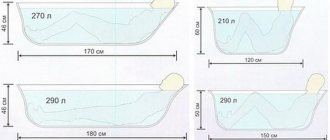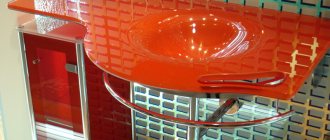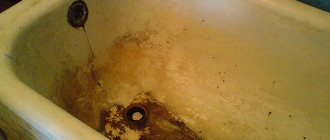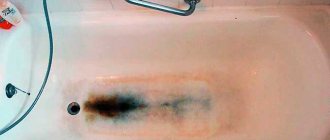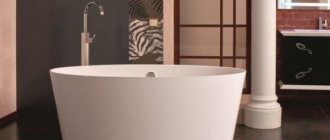Housewives often face the problem of how to wash an acrylic bathtub at home? The walls and bottom are sensitive to abrasive substances, so a product chosen at random will not work. The purpose of the article is to talk about the basic rules and methods of cleaning, give practical advice and recommendations:
- characteristics of cleaning products, their features;
- cleaning options - what they are, the main differences;
- Tips for caring for and extending the service life of your bathtub.
Acrylic is a wear-resistant material, a type of plastic that comes from a group of synthetic derivatives of one of the unsaturated organic acids.
What should you know about the characteristics of acrylic bathtubs before cleaning them?
Before answering the question of how and what to wash an acrylic bathtub, let’s talk about the material used. Acrylic has a dirt-repellent effect: microorganisms, bacteria and fungi do not develop in the bathtub. The material is durable and resistant to impacts. A noticeable disadvantage is that it is easily scratched and subject to wear.
The main difference is exposure to abrasive and chemically active components. Like plastic, substances with high alkalinity or acidity lead to degradation of the structure, and abrasives scratch the surface, leaving deep grooves.
It is important to be careful when washing. Do not buy abrasive compounds, pastes with ammonia, chlorine, acids and alkalis. Powdered products are harmful, leaving damage and scratches. Brushes (metal and with hard bristles) are contraindicated for use.
Bathroom care
Caring for an acrylic bathtub comes down to preventing persistent contamination and, as in the case of cleaning, not damaging the surface layer. To do this, it is important to observe the following preventive measures:
- Monitor the serviceability of taps, shower hoses and mixers: leaking plumbing is the main cause of rusty streams.
- Pay attention to the composition of cleaning products for faucets and shower heads that are mounted above the bathtub container or fixed above its surface. Drops of detergent will certainly fall on the surface of the bathtub and leave stains on it or cause damage to the acrylic layer if the active substance is aggressive.
- Do not exceed the exposure time of cleaning agents: after a long time, even acrylic-safe compositions can form undesirable reactions. Their most harmless consequences can be stains and discolored areas on the surface of the bathroom.
- Do not wash or soak laundry in acrylic bathtubs, especially in bleach solutions. Colored clothes may stain the container when washed.
- Avoid hitting the surface of the bathtub or dropping heavy objects on it.
- Do not place basins or other containers with hard bottoms or sharp edges in the bathtub.
- Do not burn the acrylic surface with curling irons or curling irons.
- Be careful when bathing animals: their claws can scratch the acrylic layer. Therefore, it is better to organize another place for this procedure or lay a rubber mat on the bottom of the bathroom.
- Do not pour hot water into the bath bowl, especially boiling water - it destroys acrylic, and the thin coating of a low-quality product can even melt. Safe water temperature for cast acrylic bathtubs is up to 80°C, for sandwich structures – from 50 to 70°C (depending on the thickness of the acrylic layer).
- To restore the antibacterial properties of the acrylic coating, periodically disinfect the bathtub with special solutions.
Ideally, it is recommended to wash your acrylic bathtub daily with liquid soap and be sure to wipe the surface dry after each use. But with the modern rhythm of life, it is quite difficult to implement this in practice. Therefore, it is advisable to wipe the bathtub at least once at night and clean it with a suitable product once or twice a week. Additional use of polishes will reduce the frequency of washing the acrylic bath and prolong the effect of the shiny surface.
Advice! If you need bathroom renovation specialists, there is a very convenient service for selecting specialists from PROFI.RU. Just fill out the order details, the experts will respond and you can choose who to collaborate with. Each specialist in the system has a rating, reviews and examples of work, which will help with the choice. Looks like a mini tender. Placing an application is FREE and does not oblige you to anything. Works in almost all cities of Russia.
If you are a master, follow this link, register in the system and be able to accept orders.
How to clean an acrylic bathtub at home: TOP 5 ways
We have selected several options for you on how to clean an acrylic bathtub at home:
- detergent;
- lemon acid solution;
- vinegar;
- soda;
- toothpaste.
We recommend using the methods outlined above if the contamination in the bathroom is significant (after renovation, from rust). In other cases, use special liquids available on the market.
Detergents
An adequate and simple way is to use special detergents. Their cost rarely exceeds reasonable limits. For correct selection, make sure there are no abrasives. Often the ingredients are indicated on product packaging, or special notes are made.
Acrylic bathtub cleaner is used for small and large cleaning volumes . Appearing stains are removed using:
- Cif – for bathtubs, sinks, tiles and toilets. The composition does not contain abrasives, which is safe for acrylic. The reasonable price and variety of composition types (spray, paste, cream) make it a popular product among buyers. After cleaning, a film appears that protects it from further formation of limescale.
- Acrilan - foam for baths and showers. When using, leave only until completely dry, without rinsing.
- Bass is a cleaning product that is used daily. Sold in liquid form.
- Tim-Profi is an environmentally friendly product, helps fight unpleasant odors, and is effective for heavy soiling.
- Cinderella is a popular substance that emits a pungent odor, so when spraying (sold as a spray), wear gloves and a special mask.
- Chister is a composition for quickly removing dirt, promoting the decomposition of stains and grease stains. Consists of a polymer that protects against fungi.
In addition to those listed, may be used at your own risk :
- Sarma;
- SunClean;
- Luxus professional;
- LOC Plus;
- Cillit;
- Acryl – Net;
- Star – Acrylate;
- Triton;
- RAVA K;
- Panny.
Citric acid solution
Citric acid is an organic acid with a relatively high pH - a solution indicator. The materials perfectly remove plaque, grease and other contaminants. Organic acid is especially effective in affecting ordinary substances, so it is easy to clean off fat with its help. In its pure form, it has an adverse effect on acrylic, so mix it into a solution :
- Fill ⅔ full with warm water;
- Pour out half a liter of acid;
- Mix the consistency and leave overnight;
The method is effective, but aggressive towards acrylic, and it is not recommended to carry it out more than 0.5 years.
After standing for about 12 hours, the solution descends. Citric acid should be stirred more thoroughly than vinegar - completely dissolve it for further precipitation. Finally, the structure is washed with a stream of water from the shower and wiped with a soft cloth. Rub additionally to add shine.
Apple vinegar
A practical substance, but it does not always have a positive effect on acrylic. The main feature is low pH and high acidity. For a material, this factor turns out to be critical, especially if there are scratches. You should work quickly and carefully. The recommended method is to generously soak a cloth in the solution, apply it to the stain and pour water on it.
We recommend using this method at least once every six months.
In case of heavy contamination:
- Prepare 9% vinegar in an amount of 1 liter;
- Fill two-thirds full with hot water;
- Pour out the vinegar;
- Wait for the night;
- Rinse and wipe
Soda
Regular soda removes plaque. The composition has a highly alkaline environment that breaks down fats and strong compounds. In most products it is present in the form of compounds or in its usual form. There are two types: food and calcined.
Use this method once every 3-5 months.
Baking soda is a weak alkali, while calcined soda is a strong alkali, with a powerful abrasive effect. Use only baking soda .
- Place 2-3 tablespoons of baking soda on a plate;
- Pour a glass of water;
- Wet the soft side of the sponge with the solution;
- Apply the mixture by dabbing rather than rubbing;
- After 15 minutes, rinse with water and clean with a cloth.
Never use undiluted baking soda! It has a strong abrasive effect and will damage the body.
If you need to leave the surface in its original form, use distilled or filtered water. In some cities, tap water contains large amounts of calcium, which reacts with soda to form fine sand-like particles. Using water will get rid of it. The advice is also relevant for other cleaning methods involving the use of chemically active substances.
Toothpaste
Acrylic came to plumbing from dentistry - it was used for lining the frames of dentures and making crowns, so cleaning the bathtub with toothpaste is quite acceptable.
The procedure should not be carried out more than once every two months.
Buy non-abrasive paste. The manufacturer may not indicate this on the packaging. Abrasive particles are similar to small grains of sand that remove plaque from teeth, but they will greatly damage the surface of the bathtub. Before use, squeeze a small amount of paste onto your finger and rub it - the sand is immediately noticeable.
- Apply the paste to a sponge or napkin;
- Wipe the dirty surface;
- Clean with water;
- Rub until shiny
Special means
Industrial products for acrylic are presented in the form of liquid sprays, creams or gels.
Compositions suitable for acrylic can be found among consumer household chemical products and from manufacturers of branded sanitary ware. Professional products can not only remove stains and old plaque, but also return the bathroom to its original color.
Industrial products active against plaque and dirt of various origins:
- Maline (manufacturer: Pro-brite) is a low-concentration acid-based product designed to remove lime and soap deposits on any surface;
- Cif Ultra White (Unilever) – soft cleaning cream against limescale and organic dirt;
- Gel Gloss (Grass) – created on the basis of citric acid, effective against limescale, rust and soap residues;
- Tim-Profi (Bas) is a professional solution for disinfecting and cleaning acrylic bathtubs from the most severe contaminants;
- Meine liebe is a biodegradable eco-product based on fruit acids to remove limescale;
- Sanelit (Stork) – oxygen antibacterial gel against plaque and rust;
Detergents for acrylic bathtubs. - Unicum (Bami) – antibacterial spray for cleaning Jacuzzis and removing rust and plaque on acrylic products, creates a protective coating;
- Mr. Chister (Nevskaya Cosmetics) - an antibacterial agent against limescale, rust, soap stains, forms a protective layer on the surface;
- Cinderella (Ams Media) – emulsion-cream against persistent plaque and old rust, creates a protective coating due to the silicone content;
- Acrilan (Bagi) - a spray for quickly removing old plaque and rust, creates a protective coating for up to 1 week.
Note: It is advisable to test any new product on a small area before use.
Table: type of contamination - cleaning recommendation
Let's look at the main ways to clean an acrylic bathtub:
| Problem | Solution |
| From yellow spots | Tooth paste. Cleans acrylic and returns its whiteness. |
| Rust | Soda. The structure does not scratch, but will cope with serious stains. |
| Sealant | Lemon juice. Corrodes any mixture, including sealant. |
| Limescale | Vinegar. It should be used rarely, but it does a good job of removing plaque. |
| Glue | Lemon acid. |
The nuances of cleaning a whirlpool bath
Nuances of cleaning a hydromassage bath Daily cleaning of a hydromassage bowl is carried out in the same way as a regular font. However, uninterrupted operation of nozzles, aero- and hydraulic systems is impossible without regular (at least once a month, and with regular use - once a week) maintenance of the entire set of plumbing equipment. In this case, a comprehensive cleaning of the plumbing is required.
Let's take a closer look at how to clean an acrylic whirlpool bathtub:
- the tank is filled with water at a temperature of +25-30oC;
- A special detergent is poured into the bath (the amount is indicated on the packaging or in the instructions for use). However, you can use a long-proven folk method: 2 packets of citric acid, 50 g each, are dissolved in 200 ml of warm water (you can add 100 g of concentrated lemon juice) and poured into the poured water. Everything is thoroughly mixed by hand. There is no difference between juice and acid in terms of impact on pollution. Therefore, you need to look at the cost of cleaning and buy what is cheaper;
- the aero- and hydraulic system starts up for a few minutes (5-7) at full power. Some bathtub models provide for the supply of only water - it must move through the pipes without air bubbles;
- after stopping the pumps, the bath is left alone for 2-3 hours;
- After the specified time has passed, the drain hole opens to drain the water. Here you should not be surprised if dirt comes out - it means the pipes have been washed well;
- Use cotton swabs pre-moistened in hydrogen peroxide to wipe the nozzle channels that supply water. Thus, additional cleaning of the nozzles from lime deposits is carried out;
- refill the bowl with water above the nozzles, but this time with cold water. All existing hydromassage systems are started again for 4-5 minutes, after which the water is drained again;
- The bathtub is rinsed with warm water and then wiped dry with a napkin or soft cloth.
If everything is done according to the instructions and in a timely manner (more than once every six months), the surface of the bowl will shine like new.
Contraindications: what not to use when cleaning
A few words about how not to clean an acrylic bathtub at home. We do not recommend using:
- Acetone - corrodes plastic and causes holes to appear.
- Abrasive substances damage the surface, leaving scratches and reducing the thickness of the enamel.
- A mixture of several components creates the opposite effect, scratching the walls.
The appearance of acetone in the room should be completely eliminated. The element is chemically active and acts as a solvent. 10-20 ml is enough to make a dent on the surface of the structure.
Wash off active chemicals with cold water. High temperature increases the reaction rate and surface damage will occur faster.
What is acrylic
Victory over the enemy is achieved not only by fortitude, but also by knowledge of his strengths and weaknesses. This expression fully applies to the care of acrylic bathtubs. Without knowing the characteristics of the material and its weaknesses, it is impossible to understand what means can and should be used to clean a bathtub made of such an unusual material as acrylic. The term “acrylic” hides a range of completely different polymer materials made from methacrylic and acrylic acid: fabrics, glass, plastic.
Bathtubs are made from plastic. Acrylic bathtub has a smooth, shiny surface that is pleasant to contact. The material retains heat perfectly, is technologically advanced (you can get the shape of a bowl of the most bizarre shape), and durable.
At the same time, strength is not synonymous with the word hardness - the surface of the bathtub can be easily scratched, and with a concentrated impact it can be pierced through (a glass perfume bottle falling from a shelf is enough).
The material is afraid of hot water (above 85oC the plastic softens, deforming the walls of the bowl) and household chemicals containing:
- all types of chlorine - the surface, firstly, loses its shine and turns yellow, and secondly, it slowly deteriorates (pores are formed, shortening its service life);
- acetone - corrodes plastic, the first sign of which is its cloudiness. 10 ml of acetone is enough to make a dent;
- ammonia (almost all types of bleaches) - destroys the molecular structure of the material;
- formaldehyde in its composition is incompatible with all types of acrylates;
- alcohols, alkalis, acids melt acrylates.
Therefore, it is important to take into account all the above nuances of caring for an acrylic bathtub so that it serves for a long time, delighting its owners. Let's talk about the features of care in detail.
Compatibility of detergents with acrylic surfaces
Is it possible to wash an acrylic bathtub with Domestos or a mixture of substances? It is not advisable to mix with:
- Formaldehyde - they are not compatible with acrylic.
- Chlorine - its use forms pores, shortening the service life of the product.
- Acetone , ammonia - corrode the walls.
Domestos, Sanox, Pemolux and Selite contain hydrochloric acid, which destroys protection. Initially, it is bleached, but then it absorbs plaque, becoming dirty faster. Therefore, such detergents cannot be used.
Is it possible to clean the font from yellowness and limescale with a melamine sponge?
Nowadays, melamine sponges , which consist entirely of melamine, an organic compound that is colorless crystals, are gaining immense popularity.
This substance, after reacting with water, turns into a cleaning agent and “absorbs” all contaminants into its structure.
These sponges are perfect for cleaning an acrylic bathtub, because... They do an excellent job of removing rust, yellow stains and plaque. At the same time, they are very gentle on the bathtub coating.
Disinfection with white
An acrylic bathtub is a way to forget about fungus forever, but it’s not ideal either. The fungus does not appear on the material, but easily multiplies on plaque, fats and other organic substances with nutritious microflora. Contamination should not be allowed to appear for a long time, and if it does appear, complete disinfection should be carried out periodically.
Fill the bathtub with water at room temperature;
- Add 2 liters of white (7%);
- Do not touch for 10–15 minutes;
- Rinse off the water and refill;
- Remove any remaining bleach and drain the water;
- Wipe dry with a cloth.
Do I need to disinfect the bathtub and with what?
Enlightened site visitors may have a logical question: why talk about disinfecting plastic bathtubs if fungal growth is impossible on acrylic. This is true. But we must not forget about 2 things:
- The bathtub is simply rinsed after each use (only cleanliness fanatics wash), and cleaned when free time appears. The fungus reproduces well on plaque on the walls of the bowl (fats and various organic substances are an excellent nutrient medium). Therefore, if for some reason it was not possible to thoroughly wash the font for a long period (about a month), it is advisable to completely disinfect it;
- The fungus reproduces well on silicone sealant, which is used to seal the joints between the sides of the bowl and the walls or tiles.
To protect family and friends from contact with harmful bacteria, you need to regularly carry out disinfection measures. There are several ways to do this.
Method No. 1. Buy Domestos, but only without chlorine, Acrylight, Santekh or Acrylon. To make sure that the purchased gel (paste) is suitable for an acrylic bath, you need to conduct a small experiment on a small, inconspicuous area, because Not all disinfectant containers have a warning label about the presence or absence of chlorine. If no changes are observed, then you can begin sanitation:
- the surface to be treated is rinsed with warm water, including the sealant;
- the gel is applied to a cloth or sponge;
- the entire surface of the bowl and the sealant are wiped. At the same time, you cannot leave a visible layer of the substance - a concentrated gel even without chlorine can provoke the formation of difficult to remove stains;
- after 1-2 minutes, the applied product is washed off with hot (about 60oC) water;
- The bathroom is wiped dry. If this is not done, limescale will actively form in poorly washed areas.
Method No. 2. The bath is completely filled with warm water (20-25oC). Two 1 liter bottles of “Belizna” with a bleaching agent concentration of no more than 7% are poured into it.
This solution is left in the bowl for 10-15 minutes, after which it goes down into the drain hole. Water is poured into the bath again. Use a sponge or rag to wipe the walls and bottom of the bowl. The water drains again. The bath is rinsed with warm water and then wiped dry. The disadvantage of this method is the need for additional processing of the sealant.
Attention: if there is a baby under one year old in the house, disinfection is carried out at least once a week. After its completion, the walls are washed with baby soap.
Method number 3. You can use a steam cleaner - hot steam not only kills germs, but also removes dirt, restoring the shine to the surface. It is advisable to carry out this type of treatment once every six months. The only requirement: you can’t stay in one place for a long time. The surface can be melted.
Rules for proper use
The bath does not require serious care, but it is still necessary to follow the rules.
- Periodically bringing the plumbing to a decent condition in 5 minutes - after water procedures, rinse with clean water . Acrylic does not absorb dirt, so this type of washing is sufficient.
- After use, wipe the bathtub with a sponge and soapy water . Next, dry to avoid streaks.
- restoration kits for removing scratches - they are sold in hardware stores.
Useful care tips
If you adhere to the rules for using an acrylic bathtub, then problems with the coating, as well as minor scratches, will not arise. But unfortunately, it is not always possible to follow the recommendations. Firstly, pets - it is not always possible to provide your pets with a separate washing room.
So we have to put up with them in one bathroom, using an acrylic bathtub as a container for bathing animals and for taking water treatments for all family members. Therefore, you should purchase a repair kit in advance so that it is at hand at the right time.
Secondly, you need to be extremely careful when cleaning faucets - choose a product that will be safe for the bath. After all, random drops of aggressive liquid can spoil the impeccable gloss of acrylic.
Thirdly, be sure to use protective gloves - any, even the most harmless, product can harm the delicate skin of your hands.
Fourth, when purchasing a new acrylic cleaner, it is advisable to test its action on a small piece of the bathtub to make sure that it does not damage the acrylic layer of the bathtub.
Fifth tip - if you need to fill a basin or bucket made of metal or plastic with water, it is better to place it on the floor and use a shower head to fill it.
Sixth, if colored splashes get on the acrylic surface of the bowl, for example, when washing off hair dye, children's gouache or other colorful substance, you should immediately remove them using your arsenal of bath detergents. A stubborn stain will be much more difficult to remove than a fresh one.
Useful tips will help you avoid many problems and maintain the attractiveness of your bathtub.
When choosing special products, you need to pay attention that it is a substance in the form of a cream, gel, oil, suspension or liquid. Moreover, there should be no solid inclusions, aggressive acids or solvents in the composition of the correct acrylic care product.
Another important tip is to choose the type of product that matches the nature of the contamination. So, a gel to combat limescale is unlikely to cope with rusty water stains.
Tips and tricks
To clean an acrylic bathtub more efficiently and quickly, you can use these little tricks:
- When using a paste or cream anti-limescale product, it is best not to let it dry out. If you want to leave it on the surface longer, cover the treated area with polyethylene or cling film - this will prevent the liquid from evaporating.
- When working with citric acid, it is more convenient to add ready-made lemon concentrate to the water rather than powder. To do this, mix a packet of citric acid in a small bottle, add water and shake. Pour the resulting mixture into a filled bath.
- You can combine business with pleasure: while taking a bath, add half a teaspoon of citric acid or a couple of tablespoons of vinegar to the water. This will not affect the feeling of swimming in any way, the concentration is too low, but it will increase the acidity of the water, which means it will prevent the formation of limescale.
- Powdered products are bad because when applied, chemical dust rises, which enters the respiratory tract and has a bad effect on health. To avoid this, you can fill the bath with 1-2 centimeters of water and mix the powder into a paste: this way the dust suspension will not rise, and the cleaning agent will work more effectively.
Preventing contamination
Compliance with the basic rules for using an acrylic bathtub will save you from unnecessary costs and make it easier to care for your plumbing, prolonging its service life.
№1. Do not soak laundry. The components of washing powders are not always comparable to the polymer coating. In addition, if bright clothes fade, then the bathtub has every chance of “absorbing” the paint. This property of acrylic must be taken into account when washing your hair after “fresh” painting.
№2. Taboo on bathing animals.
Pets' claws will damage the polymer coating. As an option, you can put “anti-scratch guards” on the paws and place the animal on a bedding
№3. Caring attitude. Do not place heavy objects, metal basins, etc. in a plastic tank. They can deform acrylic and leave dents and scratches.
№4. Regular care. The best way to prevent the formation of tubular stains is to clean the bathtub after each bath. Simply rinse the bowl with warm water and remove any drops with a cloth.
If it is no longer possible to tidy up the surface of the polymer plumbing fixtures, it is better to buy and install a new acrylic bathtub or carry out repair work using an acrylic liner. We advise you to read our recommended articles.
What is the best way to care for hot tubs?
Hot tubs are cleaned every few days. In this case, disinfection must be carried out, since high water temperature causes active reproduction of microorganisms. A feature of such bathtubs is also the need to clean not only its surface, but also the internal systems.
During a hydromassage session, oils and body washes should not be used; they settle on the pipes, clogging the hydromassage system. Only use sea salt and additives that are labeled as compatible with hot tubs. Avoid getting any hairspray, even hairspray, into the bathtub.
We recommend reading more about caring for hydromassage baths in a special article.
What is good about acrylic: advantages
Acrylic bathtubs
Often owners of acrylic bathtubs are interested in how to clean them properly, because such plumbing fixtures are capricious and do not tolerate careless handling. In fact, caring for acrylic is very easy, unlike other materials.
The ease of cleaning can be explained by several properties of the polymer:
- Little porosity . Acrylic has extremely small pores, if any, and therefore dirt is not absorbed, but remains on the surface. So, you can simply clean your plumbing fixtures every day with a cloth and soap and it will never lose its appearance.
- Smoothness . Due to the fact that acrylic is smooth, harmful organisms cannot penetrate the material. So no abrasives are required to clean the surface.
- By the way, manufacturers often talk about the self-cleaning effect . This does not mean that the surface cleans itself. Simply due to the smoothness, dirt is repelled. So you have to clean it less often. Most often, cleaning can be done with plain water and soap.
How to remove rust
Cleaning rust stains and stains is difficult. The following products help.
Lemon juice
Freshly squeezed juice is applied to the stain, left for no more than an hour, and washed off. To enhance the effect, add finely ground salt to the juice. So that it turns out to be a thick paste. It is applied to rust, but under no circumstances is it rubbed. Otherwise the gloss will be ruined.
Ammonia and hydrogen peroxide
The substances are quite aggressive, so their exposure should be short-term. To clean fresh rust, 5-7 minutes are enough. The ingredients are mixed in equal proportions and applied to problem areas. The maximum permissible exposure time is 10 minutes.
